Creating AI-generated pictures has become increasingly popular in recent years, with advancements in machine learning and neural networks making it possible for computers to produce stunning and lifelike images. Whether you’re an artist exploring new creative possibilities or a developer interested in the technical aspects of AI, the process of creating AI-generated pictures can be a fascinating and rewarding endeavor. In this article, we will explore the steps to create AI pictures and discuss the tools and techniques involved in the process.
Step 1: Choose a Framework or Tool
There are several frameworks and tools available for creating AI-generated images, with some of the most popular options being TensorFlow, PyTorch, and GANs (Generative Adversarial Networks). TensorFlow and PyTorch are deep learning frameworks that provide a wide range of tools and libraries for building and training neural networks. GANs, on the other hand, are a specific type of neural network architecture that has been widely used for generating realistic images. Depending on your familiarity with these tools and frameworks, you can choose the one that best suits your requirements and expertise.
Step 2: Collect and Prepare Data
The next step in creating AI-generated pictures is to collect and prepare the data that will be used to train the neural network. This may involve gathering a large number of images from sources such as online databases, stock photo websites, or your own personal collection. It’s important to ensure that the images are of high quality and cover a wide range of subjects and styles to enable the neural network to learn diverse patterns and features.
Once you’ve collected the data, you will need to preprocess and clean the images before feeding them into the neural network. Common preprocessing steps include resizing the images to a consistent size, normalizing the pixel values, and removing any noise or artifacts that could hinder the training process.
Step 3: Build and Train the Neural Network
With the data prepared, it’s time to build and train the neural network that will generate the AI pictures. This typically involves creating a deep learning model using the chosen framework and defining the architecture, layers, and parameters of the network. For GANs, the model consists of two main components: a generator network that generates images and a discriminator network that assesses the realism of the generated images.
Training the neural network involves feeding the prepared data into the model and optimizing the network’s parameters through a process called backpropagation. This process aims to minimize the difference between the generated images and the actual images in the training data, allowing the network to learn and improve its ability to produce realistic pictures.
Step 4: Generate and Evaluate AI Pictures
Once the neural network has been trained, it can be used to generate AI pictures by providing random input to the generator network and obtaining the corresponding output images. The resulting images can then be assessed for their quality, realism, and aesthetic appeal. It’s important to evaluate the generated pictures to ensure that they align with the desired criteria and reflect the style and characteristics of the training data.
Step 5: Refine and Iterate
Creating AI-generated pictures is an iterative process that often requires refinement and experimentation. After evaluating the initial set of generated images, you may identify areas for improvement or new directions to explore. This could involve adjusting the neural network’s architecture, fine-tuning the training parameters, or incorporating additional data and techniques to enhance the quality of the AI pictures.
Conclusion
Creating AI-generated pictures is a multi-faceted and dynamic process that combines artistic creativity with technical expertise. By following the steps outlined in this article and leveraging the right tools and techniques, you can embark on a journey to produce compelling and visually striking AI pictures. Whether you’re interested in exploring new artistic possibilities or delving into the intricacies of machine learning, the process of creating AI pictures offers a wealth of opportunities for innovation and expression.
